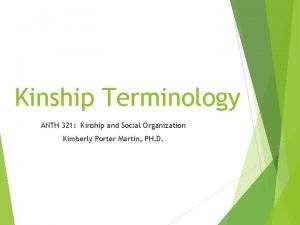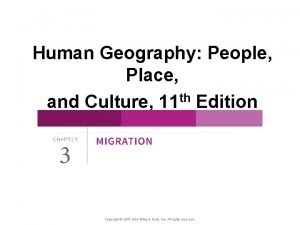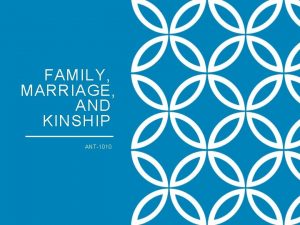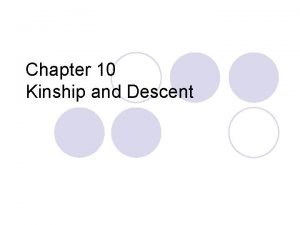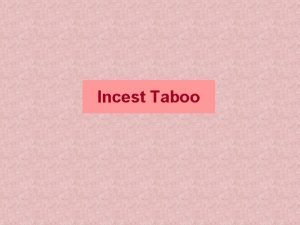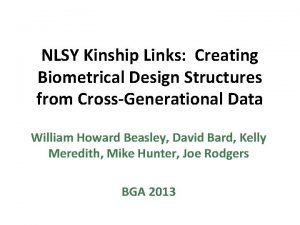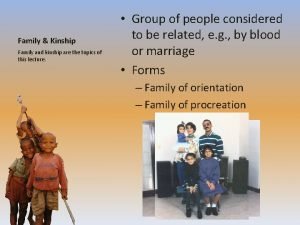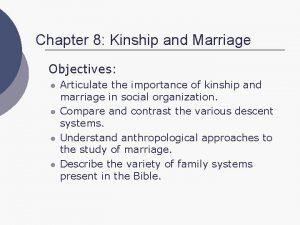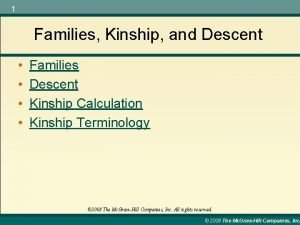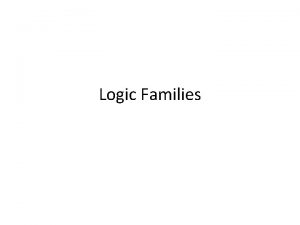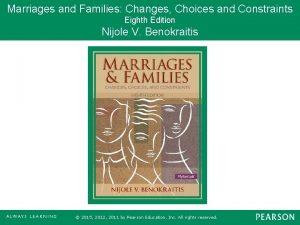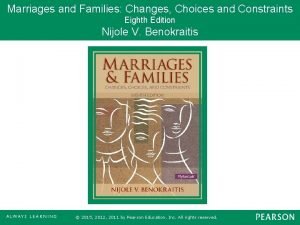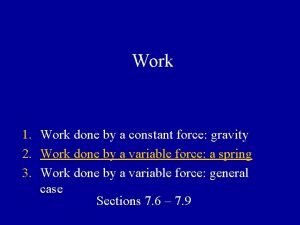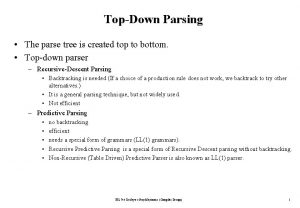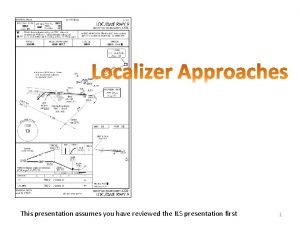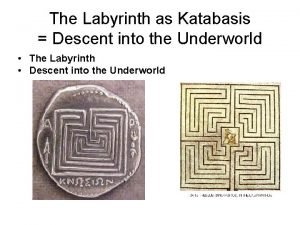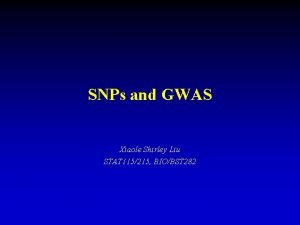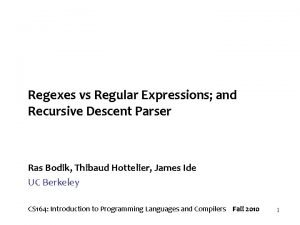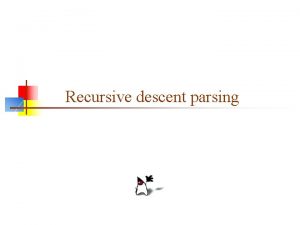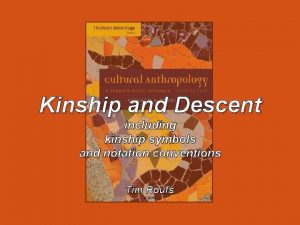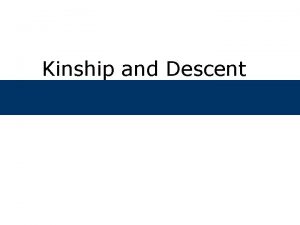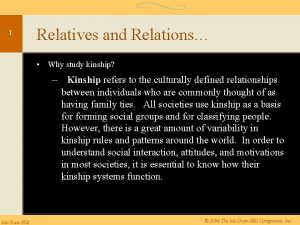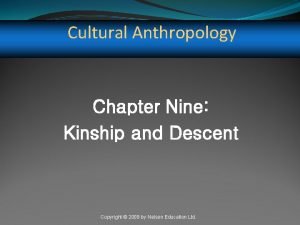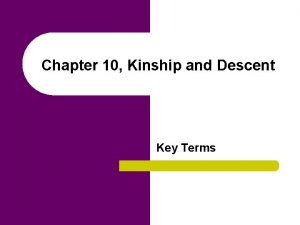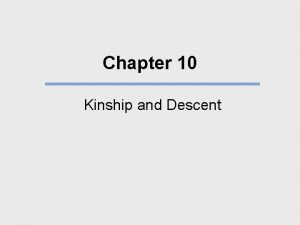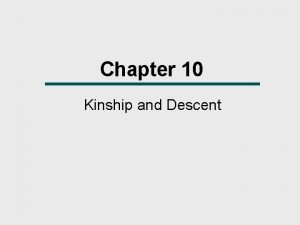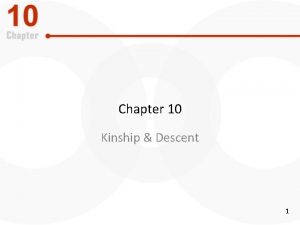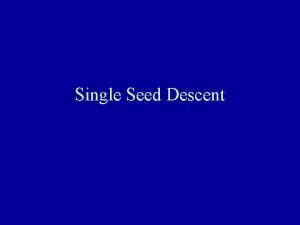1 Families Kinship and Descent Families Descent Kinship

































- Slides: 33

1 Families, Kinship, and Descent • • Families Descent Kinship Calculation Kinship Terminology © 2008 The Mc. Graw-Hill Companies, Inc. All rights reserved. © 2008 The Mc. Graw-Hill Companies, Inc.

2 Families • Understanding kinship system is essential part of anthropology • Nuclear family – consists of a married couple and their children, normally living together in same household • Extended family – consists of three or more generations © 2008 The Mc. Graw-Hill Companies, Inc. All rights reserved. © 2008 The Mc. Graw-Hill Companies, Inc.

3 Families • Descent groups – lineages and clans – Family of orientation – family in which one is born and grows up – Family of procreation – formed when one marries and has children • In most societies, relations with nuclear family members take precedence over relations with other kin • Nuclear family widespread, but not universal © 2008 The Mc. Graw-Hill Companies, Inc. All rights reserved. © 2008 The Mc. Graw-Hill Companies, Inc.

4 Families • Where nuclear family is important, it is primary arena for sexual, reproductive, economic, and enculturative functions • In many societies, extended families are primary unit of social organization – Muslims of western Bosnia – nuclear families within large extended families called zadrugas – Nayars – matrilineal society in which extended families live in compounds called tarawads © 2008 The Mc. Graw-Hill Companies, Inc. All rights reserved. © 2008 The Mc. Graw-Hill Companies, Inc.

5 Location of the Nayars in India’s Kerala Province © 2008 The Mc. Graw-Hill Companies, Inc. All rights reserved. © 2008 The Mc. Graw-Hill Companies, Inc.

6 Industrialism and Family Organization • Most prevalent residence pattern in U. S. is family of procreation living neolocally. – Neolocality – married couples may live hundreds of miles from parents © 2008 The Mc. Graw-Hill Companies, Inc. All rights reserved. © 2008 The Mc. Graw-Hill Companies, Inc.

7 Changes in North American Kinship • Nuclear families accounted for 23% of American households in 2003 -2004 – Increasing representation of women in the work force associated with rise in marriage from 21 years in 1970 to 25 in 2003 – Between 1970 and 2003 the number of divorced Americans rose from 4. 3 million to 22 million – Number of single-parent families outstripped population growth, from fewer than 4 million in 1970 to 16 million in 2003 © 2008 The Mc. Graw-Hill Companies, Inc. All rights reserved. © 2008 The Mc. Graw-Hill Companies, Inc.

8 Changes in North American Kinship • About 57% American women and 60% percent American men currently married in 2004 • Growing isolation from kin may well be unprecedented in human history • Major contrast with Brazilians, who much prefer to live in social world with relatives (less mobile society) © 2008 The Mc. Graw-Hill Companies, Inc. All rights reserved. © 2008 The Mc. Graw-Hill Companies, Inc.

9 Changes in Family and Household Organization in the United States: 1970 versus 2004 Sources: From U. S. Census data in J. M. Fields, “America’s Families and Living Arrangements: 2003, ” Current Population Reports, P 20 -553, November 2004, http: //www. census. gov/prod/2004 pubs/p 20553. pdf, p. 4; J. M. Fields and L. M. Casper, “America’s Families and Living Arrangements: 2000, ” Current Population Reports, P 20 -557. pdf; U. S. Census Bureau, Statistical Abstract of the United States, 2006, Tables 55, 56, and 65. http: //www. census. gov/prod/www/statistical_abstract. html. © 2008 The Mc. Graw-Hill Companies, Inc. All rights reserved. © 2008 The Mc. Graw-Hill Companies, Inc.

10 Households by Type: Selected Years, 1970 to 2003 (percent distribution) Sources: U. S. Census Bureau, Current Population Survey, March and Annual Social and Economic Supplements: 1997 to 2003; J. M. Fields, “America’s Families and Living Arrangements: 2003, ” Current Population Reports, P 20 -553, November 2004. http: //www. census. gove/prod/2004 pubs /p 20 -553. pdf, p. 4. © 2008 The Mc. Graw-Hill Companies, Inc. All rights reserved. © 2008 The Mc. Graw-Hill Companies, Inc.

11 Ratio of Divorces to Marriages per 1, 000 U. S. Population, Selected Years, 1950 -2003 Source: U. S. Census Bureau, Statistical Abstract of the United States 2006, Tables 71, p. 64. http: //www. census. gov/prod/www/statistical_abstract. html © 2008 The Mc. Graw-Hill Companies, Inc. All rights reserved. © 2008 The Mc. Graw-Hill Companies, Inc.

12 Ratio of Divorces to Marriages per 1, 000 U. S. Population, Selected Years, 1950 -2003 Source: J. M. Fields, “American Families and Living Arrangements: 2003, ” Current Population Reports, P 20 -553, November 2004. http: //www. census. gov/prod/2004 pubs/p 20 -553. pdf, pp. 3 -4. U. S. Census Bureau, Statistical Abstract of the United States, 2004 -5; Statistics Canada, 2001 Census. http: //www. statcan. co/english/Pgdb/famil 53 a. htm, http: //www. statcan. co/english/Pgdb/famil 40 a. htm. © 2008 The Mc. Graw-Hill Companies, Inc. All rights reserved. © 2008 The Mc. Graw-Hill Companies, Inc.

13 The Family among Foragers • The two basic units of social organization among foragers are the nuclear family and the band • Typically, band exists only seasonally, breaking up into nuclear families when subsistence means require (seasons of meager resources) © 2008 The Mc. Graw-Hill Companies, Inc. All rights reserved. © 2008 The Mc. Graw-Hill Companies, Inc.

14 Descent Groups • Matrilineal descent – individuals automatically join mother’s descent group when they are born • Patrilineal descent – individuals automatically join father’s descent group when they are born • Unilineal descent – descent rule only uses one line © 2008 The Mc. Graw-Hill Companies, Inc. All rights reserved. © 2008 The Mc. Graw-Hill Companies, Inc.

15 Descent Groups • Lineage – descent group who can demonstrate their common descent from apical ancestor (e. g. , Adam) (demonstrated descent; memorized, but not necessarily accurate, genealogies) • Clan – descent group who claims common descent from an apical ancestor but cannot demonstrate it (stipulated descent, ) © 2008 The Mc. Graw-Hill Companies, Inc. All rights reserved. © 2008 The Mc. Graw-Hill Companies, Inc.

16 A Matrilineage Five Generations Deep Matrilineages are based on demonstrated descent from a female ancestor. Only the children of the group’s women (blue) belong to the matrilineage. The children of the group’s men are excluded; they belong to their mother’s matrilineage. © 2008 The Mc. Graw-Hill Companies, Inc. All rights reserved. © 2008 The Mc. Graw-Hill Companies, Inc.

17 A Patrilineage Five Generations Deep Lineages are based on demonstrated descent from a common ancestor. With patrileneal descent, children of the group’s men (blue) are included as descent-group members. Children of the group’s female members are excluded; they belong to their father’s patrilineage. Also notice lineage exogamy. © 2008 The Mc. Graw-Hill Companies, Inc. All rights reserved. © 2008 The Mc. Graw-Hill Companies, Inc.

18 Lineages, Clans, and Residence Rules • In tribal societies, descent group, not nuclear family, is fundamental unit • In many societies, descent groups are corporate, sharing resources and property © 2008 The Mc. Graw-Hill Companies, Inc. All rights reserved. © 2008 The Mc. Graw-Hill Companies, Inc.

19 Unilineal Descent Rules • Patrilocality – married couple lives with husband’s family; associated with patrilineal descent and more common than matrilocality • Matrilocality – married couple lives with wife’s family; associated with matrilineal descent and less common than patrilocality © 2008 The Mc. Graw-Hill Companies, Inc. All rights reserved. © 2008 The Mc. Graw-Hill Companies, Inc.

20 Ambilineal Descent Rules • People can choose the descent group they want to belong to – Membership is fluid – Membership achieved • Membership ascribed in unilineal descent © 2008 The Mc. Graw-Hill Companies, Inc. All rights reserved. © 2008 The Mc. Graw-Hill Companies, Inc.

21 Family versus Descent • Many societies have both families and descent groups – Obligations to one may conflict with obligations to the other – More conflicts for men in matrilineal societies (descent continuity through own matriliny versus obligations to own wife/child – Compared to patrilineal systems, matrilineal societies tend to have higher divorce rates and greater female promiscuity © 2008 The Mc. Graw-Hill Companies, Inc. All rights reserved. © 2008 The Mc. Graw-Hill Companies, Inc.

22 Kinship Calculation • System by which people in a society reckon kin relationships (kinship is culturally constructed) – Kin terms – labels given in particular culture to different kinds of relatives (e. g. , uncle) – Biological kin type – degree of actual genealogical relatedness (kinship notation, e. g. , FB, MB) – Bilateral kinship – people tend to perceive kin links through males and females as being similar or equal © 2008 The Mc. Graw-Hill Companies, Inc. All rights reserved. © 2008 The Mc. Graw-Hill Companies, Inc.

23 Lineal Terminology • Native taxonomy developed over generations by the people who live in particular society – Our own system of kinship classification called lineal kinship terminology – Lineal relative – ancestor or descendant – Collateral relatives – all other kin – Affinals – relatives by marriage © 2008 The Mc. Graw-Hill Companies, Inc. All rights reserved. © 2008 The Mc. Graw-Hill Companies, Inc.

24 Bifurcate Merging Terminology • Splits mother’s side from father’s side, but also merges same-sex siblings of each parent – Associated with unilineal descent and unilocal residence © 2008 The Mc. Graw-Hill Companies, Inc. All rights reserved. © 2008 The Mc. Graw-Hill Companies, Inc.

25 Generational Terminology • Uses same term for parents and their siblings, but lumping is more complete – Typical of ambilineal societies © 2008 The Mc. Graw-Hill Companies, Inc. All rights reserved. © 2008 The Mc. Graw-Hill Companies, Inc.

26 Bifurcate collateral terminology • Separate terms used for each of the six kin types of the parental generation – Common to North Africa and the Middle East – Most particular system © 2008 The Mc. Graw-Hill Companies, Inc. All rights reserved. © 2008 The Mc. Graw-Hill Companies, Inc.

27 Kinship Symbols and Genealogical Kin Type Notation © 2008 The Mc. Graw-Hill Companies, Inc. All rights reserved. © 2008 The Mc. Graw-Hill Companies, Inc.

28 Lineal Kinship Terminology © 2008 The Mc. Graw-Hill Companies, Inc. All rights reserved. © 2008 The Mc. Graw-Hill Companies, Inc.

29 The Distinctions among Lineals, Collaterals, and Affinals as Perceived by Ego © 2008 The Mc. Graw-Hill Companies, Inc. All rights reserved. © 2008 The Mc. Graw-Hill Companies, Inc.

30 Bifurcate Merging Kinship Terminology © 2008 The Mc. Graw-Hill Companies, Inc. All rights reserved. © 2008 The Mc. Graw-Hill Companies, Inc.

31 Generational Kinship Terminology © 2008 The Mc. Graw-Hill Companies, Inc. All rights reserved. © 2008 The Mc. Graw-Hill Companies, Inc.

32 Bifurcate Collateral Kinship Terminology © 2008 The Mc. Graw-Hill Companies, Inc. All rights reserved. © 2008 The Mc. Graw-Hill Companies, Inc.

33 The Four Systems of Kinship Terminology, with Social and Economic Correlates © 2008 The Mc. Graw-Hill Companies, Inc. All rights reserved. © 2008 The Mc. Graw-Hill Companies, Inc.
 Big families vs small families
Big families vs small families Kinship terminology
Kinship terminology Kinship
Kinship Vertical function of kinship
Vertical function of kinship Periodic movement definition ap human geography
Periodic movement definition ap human geography Kinship systems
Kinship systems Hawaiian kinship system
Hawaiian kinship system Hawaiian kinship system
Hawaiian kinship system Biological kinship
Biological kinship Kinship links definition
Kinship links definition Kinship diagram symbols
Kinship diagram symbols Cross vs parallel cousins
Cross vs parallel cousins Aima slides
Aima slides Islamic hadith
Islamic hadith A strong affection for another person due to kinship
A strong affection for another person due to kinship Lineal kinship terminology
Lineal kinship terminology Texas descent and distribution before 1993
Texas descent and distribution before 1993 Jvp cm
Jvp cm What are the characteristics of logic families
What are the characteristics of logic families Compare and contrast the bach and marsalis families
Compare and contrast the bach and marsalis families Compare and contrast the bach and marsalis families
Compare and contrast the bach and marsalis families Marriages and families 8th edition
Marriages and families 8th edition Marriages and families changes choices and constraints
Marriages and families changes choices and constraints The work done by gravity during the descent of a projectile
The work done by gravity during the descent of a projectile Vda jeppesen
Vda jeppesen Recursive descent parsing
Recursive descent parsing Visual descent point
Visual descent point Recursive descent parser calculator java
Recursive descent parser calculator java Descent into underworld
Descent into underworld Gradient descent equation
Gradient descent equation Identical by descent vs identical by state
Identical by descent vs identical by state Recursive descent parser
Recursive descent parser Recursive descent parser
Recursive descent parser Limitations of recursive descent parser
Limitations of recursive descent parser

